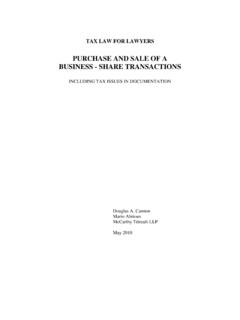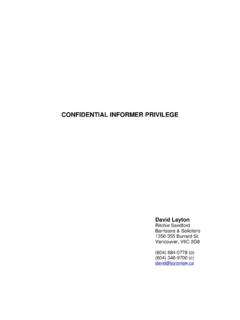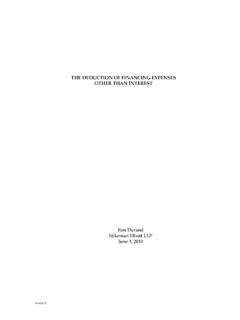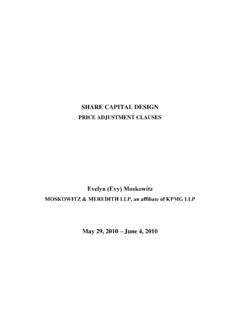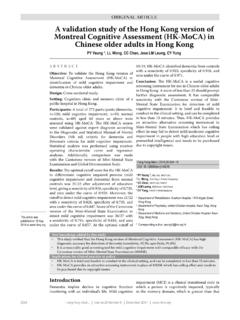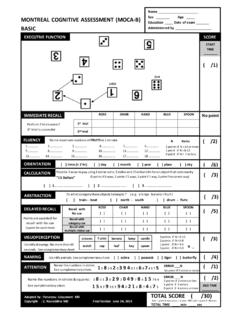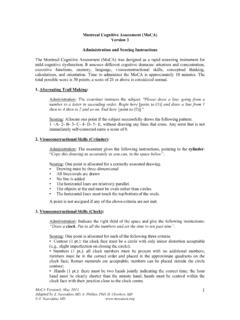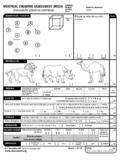Transcription of INTERPRETATION OF COMMON COGNITIVE …
1 INTERPRETATION OF COMMON COGNITIVE SCREENING TESTS Kenneth I Shulman MD INTRODUCTION Standardized COGNITIVE screening instruments have become an essential component of the assessment of mental and COGNITIVE function in older adults. In assessing mental capacities, lawyers will encounter the results of various COGNITIVE screening tests and need to have a reasonable understanding of how to interpret the test results and place them in context in the determination of legal capacity. The first principle to establish is that the results of COGNITIVE screening tests are not diagnostic. One can have a diagnosis of dementia or Alzheimer s disease and still be capable.
2 Conversely, one can have a normal COGNITIVE screening result and lack capacity. Diagnosis is dependent not just on a COGNITIVE screening test but on a clinical assessment including history and investigations. Similarly, capacity is always task specific and situation specific. Capacity is not dependent on diagnosis or on the mental state of the individual, but rather on the specific components of a mental capacity. For example, in the Banks V. Goodfellow criteria1 for testamentary capacity, one can still have a delusion, and if it does not influence the disposition, an individual may still be considered capable. An individual may suffer from COGNITIVE impairment and be incapable of managing property yet have a clear and consistent rationale for identifying specific beneficiaries.
3 Capacity is also situation specific and is influenced by the level of conflict and complexity in the environment of an individual. From a clinical perspective, in such an environment the threshold for capacity increases as an individual attempts to understand relevant facts and appreciate the consequences of specific actions the basic components of all mental capacities. A poor COGNITIVE screening result is a signal and not a conclusive finding. In establishing a diagnosis a clinician must factor in history, mental status examination as well as imaging and biochemical investigations. WHAT IS SCREENING ? The term screening is used in an epidemiological sense in describing population screening, which includes the testing of asymptomatic individuals without risk factors.
4 Clinically, we use the term screening as opportunistic case finding - that is, the testing of high-risk individuals. In Dementia, this means those individuals of great age, positive family history for dementia or those with a history of risk factors for dementia such as major depression, head injury or delirium. The main psychometric properties that determine the value of a screening test include sensitivity and specificity. Sensitivity is a measure of the correct identification of true positives , that is, the probability of testing positive if the disease is truly present. A low sensitivity will lead to a high number of false negatives.
5 1 Banks v Goodfellow. (1870) LR5 QB, 549. Specificity is a measure of the correct identification of true negatives -that is, the probability of testing negative if the disease is truly absent. A low specificity will lead to a large number of false positives. Besides having a relatively high sensitivity and specificity, an ideal screening test should have the properties of being relatively quick, well tolerated and easy to administer and score. It should be relatively independent of the influence of culture, language and education and cast a wide net with respect to the major COGNITIVE A screening test that misses major domains will be problematic.
6 MOST COMMONLY USED SCREENING TESTS 1. The Mini-Mental State Examination (MMSE). The most widely used and cited COGNITIVE screening test is known as the Mini-Mental State Examination (MMSE), sometimes as the Folstein test after its originator2, Marshall Folstein. It is a test that is scored out of 30 and includes assessment of orientation to time, orientation to place, short-term memory, concentration, language and visuospatial abilities. Importantly, the MMSE does not test executive brain functions or frontal lobe functions including judgment, planning or impulsivity, all of which may be very relevant to the question of mental capacity. The norms are based on education and language.
7 While there is a cohort effect in terms of the cutoff for any individual, there is no firm individual cutoff for a diagnosis of dementia. 2. The Clock Drawing Test (CDT). The clock-drawing test has become very popular screening test because it is quick and easy to administer3. It includes a wide range of COGNITIVE functions, which is desirable in a COGNITIVE screening test. These COGNITIVE functions include comprehension, planning, visual memory, visuospatial ability, motivation and concentration. Scoring is a challenge, however, in the clock-drawing test, and it has become increasingly clear that a simple approach to scoring is best for the clock-drawing test.
8 In most cases this means a global assessment of the result as intact, mildly, moderately or severely impaired. The value of the CDT or any COGNITIVE screening test for that matter is that it provides a baseline for change over time. One can determine whether cognition is getting better, worse or is stable by following a standardized test over time. 3. Mini-Cog The Mini-Cog is simply a combination of a three-word delayed recall test followed by the clock-drawing test. It has proven to have excellent psychometric properties in predicting dementia 4. 2 Folstein, , Folstein, and McHugh, "Mini-mental state".
9 A practical method for grading the COGNITIVE state of patients for the clinician. J Psychiatr Res, 1975. 12(3): p. 189-98 3 Shulman, , Clock-drawing: is it the ideal COGNITIVE screening test? Int J Geriatr Psychiatry, 2000. 15(6): p. 548-61 4 Borson, S., et al., The mini-cog: a COGNITIVE 'vital signs' measure for dementia screening in multi-lingual elderly. Int J Geriatr Psychiatry, 2000. 15(11): p. 1021-7. 4. The montreal COGNITIVE assessment ( moca )5 The moca was designed primarily to test for mild COGNITIVE impairment and is therefore a more sensitive and difficult test than the MMSE. Importantly, it includes a number of executive/frontal tests including the trails B test, which calls for alternating numbers and letters in pursuing a trail.
10 It includes the clock-drawing test, verbal fluency as well as test of abstraction using similarities. 5. Frontal Lobe Tests The testing of specific frontal/executive brain functions is based largely on the phenomenon of set shifting. It has been said: the damaged brain is a sticky brain. Hence, tests that call for alternating responses such as the trails B test, the Go-No-Go and the Luria three-step test are examples of this type of set shifting. Frontal tests correspond to important COGNITIVE functions such as planning, judgment and impulsivity precisely those COGNITIVE functions that are critical to complex mental capacities such as the capacity for personal care, capacity to manage property or testamentary capacity.
